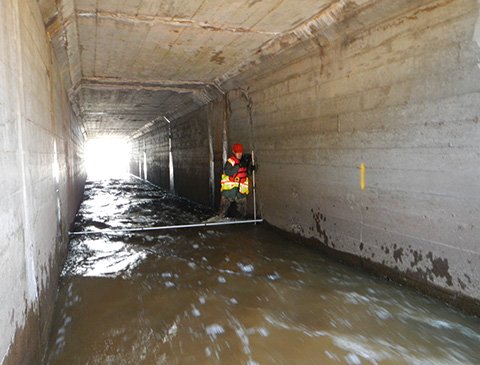Experiments on Fish-Friendly Culvert Design

Project Summary:
Culverts can be partial or total barriers to fish movement. The passibility of any particular culvert depends on the culvert design, the stream hydrology and flow regime, and the target fish species and life stages needing to pass through the culvert. Current culvert designs incorporating fish passage elements include baffles and culvert retrofits, placing sediment and other roughness elements within a culvert barrel to slow water velocities through the culvert, and incorporating an open bottom span (bottomless culvert). However, crossing designs that incorporate a range of streambed roughness characteristics (moving beyond meeting individual hydraulic criteria for target species) to replicate natural stream conditions within the culvert barrel best ensure the passage of entire aquatic communities. An example of this approach is the United States Department of Agriculture Forest Service (USFS) Stream Simulation method (USFS 2008). The premise of Stream Simulation is that if channel characteristics through a road-stream crossing are similar to the natural channel, fish and other aquatic organism movement through the culvert should be no more difficult than movement in the larger stream network. Design elements specific to this method include installing a culvert wider than the channel width into the stream bed and replicating the stream slope, variation in channel geometry, bed forms, and sediment size characteristics of the natural channel within the culvert. Due to a larger cross-sectional size and installation costs, these culverts have a larger initial investment, but recent studies suggest that Stream Simulation culverts are more resilient to extreme flows and may yield substantial societal and economic benefits.
In practice, many state, county, and local agencies have adopted some version of the Stream Simulation culvert design for fish passage by installed recessed culverts, or culverts set below the streambed. As the culvert is expected to fill with sediment over time, the culvert is generally not filled with sediment or roughness elements after installation. This strategy, however, does not necessarily work, evidenced by a lack of sediment in recessed culverts in the field. Recent research sponsored by the Minnesota Department of Transportation (MnDOT) conducted at the St. Anthony Falls Laboratory (SAFL) at the University of Minnesota looked more closely at this issue, setting up a number of experiments to investigate sediment transport dynamics of recessed culverts in a controlled setting.
SAFL researchers used a tilting bed flume to create several 1:8 model streams with three different slopes. Using these models, they tested the effectiveness of two culvert installation methods: one in which the culvert was placed below the streambed but not filled with sediment after installation, and another in which the culvert was filled with sediment after installation. Researchers then used a range of flow scenarios – from baseflow to overbank flood events – to observe the resulting sediment transport dynamics.
Project Outcomes:
Results demonstrated that not filling the culvert with sediment after installation did not necessarily lead to culvert infilling and in fact, could lead to scour and channel instabilities upstream of the culvert. Inversely, filling the culvert with sediment as part of the installation process allowed sediment transport through the culvert, maintained natural streambed roughness within the culvert and most importantly, helped to prevent upstream scour and erosion. For steeper streams where the bed roughness is dominated by large roughness elements (boulders) that are not mobile at smaller flood events, researchers found that the addition of structures such as steps and boulders was critical to the stability of sediment within the culvert. In addition, adding structures to the high gradient culvert protected the stream stability upstream of the culvert.
Using these observations, a number of design recommendations for recessed culverts were developed for culverts where maintaining a natural streambed through the culvert is desired to preserve fish and other aquatic organism passage. These recommendations include making the culvert at least as wide as the width of the stream, conducting a site specific analysis of flow, shear stress and mobility of the range of sediment sizes to predict sediment movement into the culvert, pre-filling the culvert with sediment that matches the sediment in the existing streambed, and installing structures within the culvert for streams with steeper slopes to maintain sediment stability and provide resting places for fish traveling upstream. Additional design challenges for recessed or embedded culverts include multi-barrel culverts, vegetation growth, accounting for streambed armoring, and maintaining adequate depth during low flows in wider culverts.
Sponsor:
Minnesota Department of Transportation (MnDOT)
Project Team:
Jessica Kozarek, SAFL Research Associate and Project Manager, St. Anthony Falls Laboratory, University of Minnesota
Project Details:
The overall project began xx and was completed in xx.
Project Report:
In Progress.
